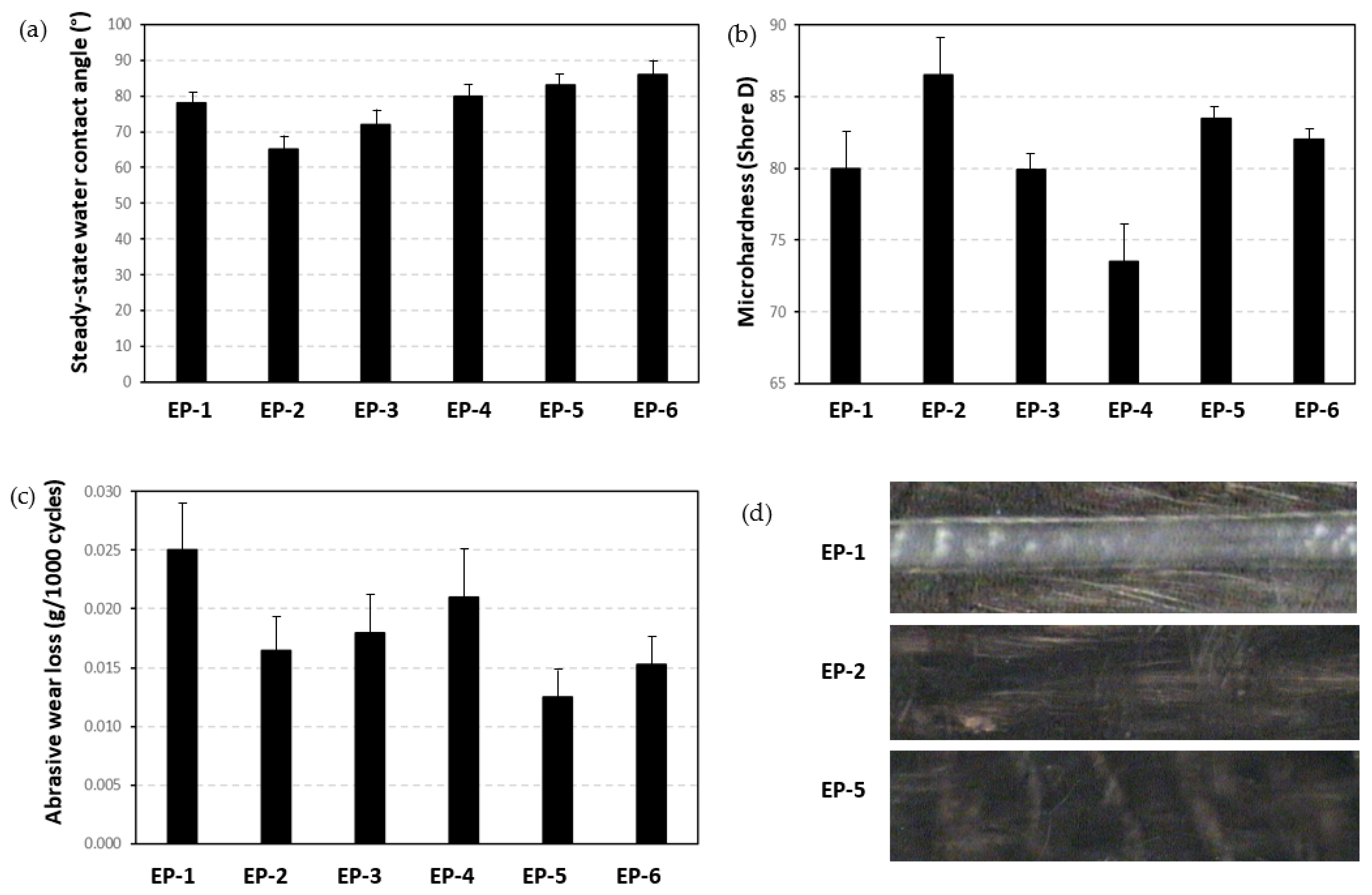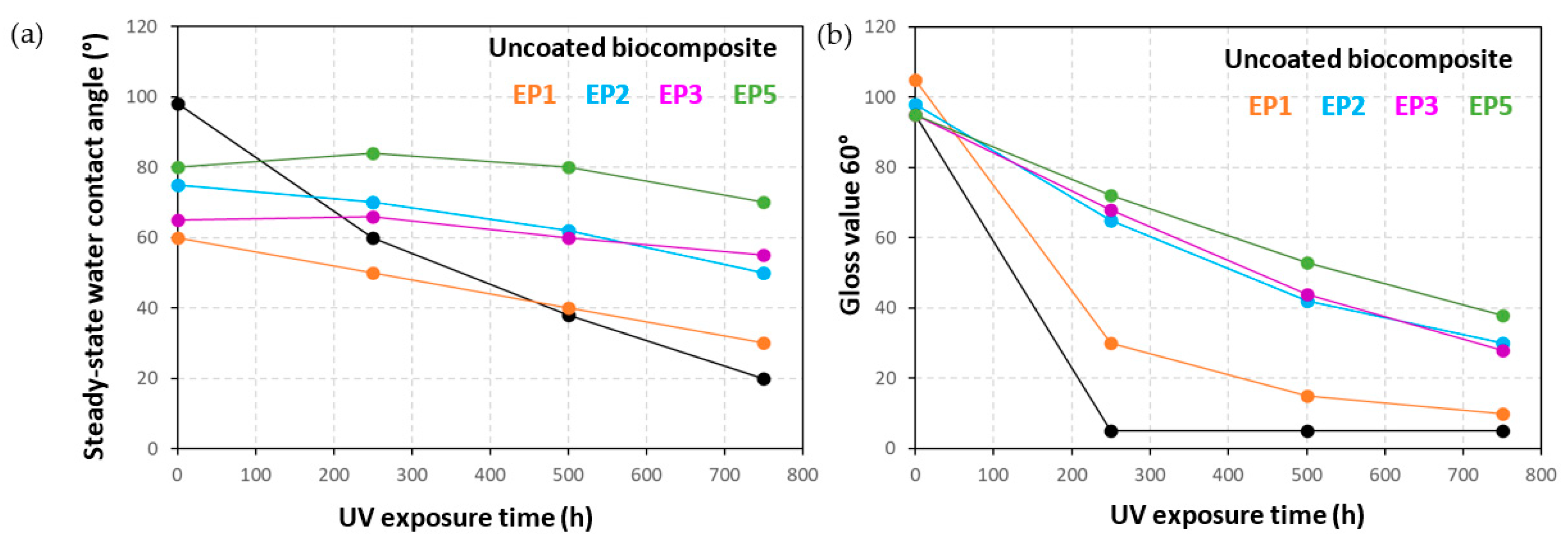Mechanical Performance of Protective Epoxy Coatings with Bio-Based Ingredients for Flax–Fiber Composites †
Abstract
:1. Introduction
2. Materials and Methods
2.1. Biocomposite Substrates
2.2. Coating Application
2.3. Characterization Methods for Coated Composites
3. Results and Discussion
3.1. Performance of Linseed Oil and Wax Coating
3.2. Performance of Bio-Based Epoxy Coatings
4. Conclusions
Author Contributions
Funding
Institutional Review Board Statement
Informed Consent Statement
Data Availability Statement
Conflicts of Interest
References
- Karuppannan, G.S.; Kärki, T. A review on the recycling of waste carbon fibre/glass fbre-reinforced composites: Fibre recovery, properties and life-cycle analysis. SN Appl. Sci. 2020, 2, 433. [Google Scholar]
- Beus, N.D.; Carus, M.; Barth, M. Carbon Footprint and Sustainability of Different Natural Fibres for Biocomposites and Insulation Material; Nova Institute for Ecology and Innovation: Hürth, Germany, 2019. [Google Scholar]
- Bi, X.; Zhang, W.; Yu, C.; Yang, J. UV resistance of bast fibers. Cellulose 2019, 26, 6061–6071. [Google Scholar] [CrossRef]
- Moudood, A.; Rahman, A.; Öchsner, A.; Islam, M.; Francucci, G. Flax fiber and its composites: An overview of water and moisture absorption impact on their performance. J. Reinforced Plast. Comp. 2019, 38, 323–339. [Google Scholar] [CrossRef]
- Gautreau, M.; Kervoelen, A.; Barteau, G. Fibre individualisation and mechanical properties of a flax-PLA non-woven composite following physical pre-treatments. Coatings 2021, 11, 846. [Google Scholar] [CrossRef]
- Alix, S.; Philippe, E.; Bessadok, A.; Lebrun, L.; Morvan, C.; Marais, S. Effect of chemical treatments on water sorption and mechanical properties of flax fibres. Bioresource Technol. 2009, 100, 4742–4749. [Google Scholar] [CrossRef] [PubMed]
- Garai, R.M.; Sánchez, I.C.; García, R.T. Study on the effect of raw material composition on water-repellent capacity of paraffin wax emulsions on wood. J. Dispesion Sci. Technol. 2005, 26, 9–18. [Google Scholar] [CrossRef]
- Andersone, I.; Kuka, E.; Cīrule, D.; Sansonetti, E.; Andersons, B. Investigation of linseed oil based wood coatings: Effect of artificial weathering. Key Eng. Mater. 2019, 800, 223–227. [Google Scholar]
- ASTM D2240; Standard Test Method for Rubber Property—Durometer Hardness. American Society for Testing and Materials: West Conshohocken, PA, USA, 2021.
- ISO 4586-2; High-pressure decorative laminates—Sheets made from thermosetting resins, Part 2: Determination of properties. International Organization for Standardization: Geneva, Switzerland, 2004.
- ASTM D4060-10; Standard Test Method for Abrasion Resistance of Organic Coatings by the Taber Abraser. American Society for Testing and Materials: West Conshohocken, PA, USA, 2010.
- ASTM G154-23; Standard Practice for Operating Fluorescent Ultraviolet (UV) Lamp Apparatus for Exposure of Materials. American Society for Testing and Materials: West Conshohocken, PA, USA, 2012.



| Sample | Material | Dry Thickness | Aging |
|---|---|---|---|
| LO-1 | Linseed oil | 100 µm | 1, 4, 8 weeks |
| LO-2 | Linseed oil | 300 µm | 1, 4, 8 weeks |
| PW-1 | Paraffin wax | 100 µm | 1, 4, 8 weeks |
| PW-2 | Paraffin wax | 300 µm | 1, 4, 8 weeks |
| Sample | DGEBA Bio-Epoxy Resin | DGE Fossil-Diluent | TGE Bio-Diluent | FA Crosslinker | PK Crosslinker |
|---|---|---|---|---|---|
| EP-1 | 10 | - | - | 5 (2:1) | - |
| EP-2 | 10 | - | - | - | 6.25 (1.6:1) |
| EP-3 | 10 | 2 | - | - | 6.7 (1.6:1) |
| EP-4 | 10 | 5 | - | - | 7.1 (1.6:1) |
| EP-5 | 10 | - | 2 | - | 6.7 (1.6:1) |
| EP-6 | 10 | - | 5 | - | 7.1 (1.6:1) |
Disclaimer/Publisher’s Note: The statements, opinions and data contained in all publications are solely those of the individual author(s) and contributor(s) and not of MDPI and/or the editor(s). MDPI and/or the editor(s) disclaim responsibility for any injury to people or property resulting from any ideas, methods, instructions or products referred to in the content. |
© 2023 by the authors. Licensee MDPI, Basel, Switzerland. This article is an open access article distributed under the terms and conditions of the Creative Commons Attribution (CC BY) license (https://creativecommons.org/licenses/by/4.0/).
Share and Cite
Samyn, P.; Lembrechts, W.; Cosemans, P.; De Vriese, L. Mechanical Performance of Protective Epoxy Coatings with Bio-Based Ingredients for Flax–Fiber Composites. Eng. Proc. 2023, 56, 39. https://doi.org/10.3390/ASEC2023-15327
Samyn P, Lembrechts W, Cosemans P, De Vriese L. Mechanical Performance of Protective Epoxy Coatings with Bio-Based Ingredients for Flax–Fiber Composites. Engineering Proceedings. 2023; 56(1):39. https://doi.org/10.3390/ASEC2023-15327
Chicago/Turabian StyleSamyn, Pieter, Wannes Lembrechts, Patrick Cosemans, and Linde De Vriese. 2023. "Mechanical Performance of Protective Epoxy Coatings with Bio-Based Ingredients for Flax–Fiber Composites" Engineering Proceedings 56, no. 1: 39. https://doi.org/10.3390/ASEC2023-15327
APA StyleSamyn, P., Lembrechts, W., Cosemans, P., & De Vriese, L. (2023). Mechanical Performance of Protective Epoxy Coatings with Bio-Based Ingredients for Flax–Fiber Composites. Engineering Proceedings, 56(1), 39. https://doi.org/10.3390/ASEC2023-15327






